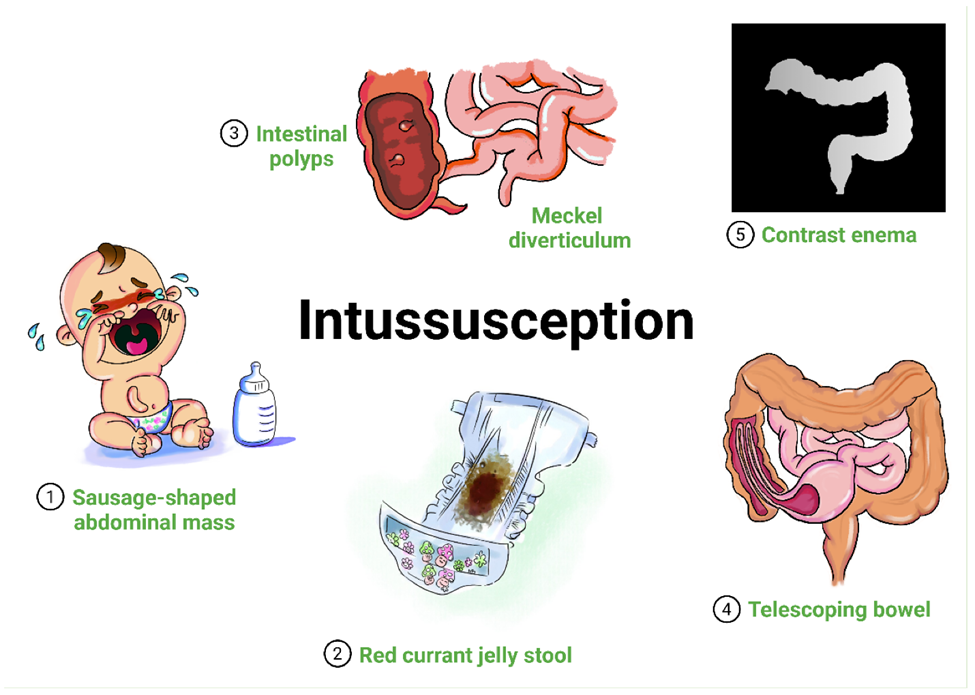The nurse is preparing to care for a child with a diagnosis of intussusception. The nurse reviews the child's record and expects to note which sign of this disorder documented?
Ribbon-like stools
Profuse projectile vomiting
Bright red blood and mucus in the stools
Watery diarrhea
The Correct Answer is C
A. Ribbon-like stools
Explanation: Ribbon-like or pencil-thin stools are associated with conditions affecting the rectum, such as colorectal cancer, but they are not a typical sign of intussusception.
B. Profuse projectile vomiting
Explanation: Profuse projectile vomiting is not a typical sign of intussusception. Vomiting may occur, but it is not the primary characteristic feature.
C. Bright red blood and mucus in the stools
Explanation:
Intussusception is a condition in which one part of the intestine slides into another, causing a blockage. One of the classic signs of intussusception is the presence of "currant jelly" stools, which are characterized by a mixture of bright red blood and mucus in the stools. This occurs due to the compression of the blood vessels in the intestine, leading to bleeding and mucosal discharge.
D. Watery diarrhea
Explanation: Watery diarrhea is not a typical sign of intussusception. The condition is more commonly associated with abdominal pain, vomiting, and the characteristic "currant jelly" stools.

Nursing Test Bank
Naxlex Comprehensive Predictor Exams
Related Questions
Correct Answer is C
Explanation
A. Ribbon-like stools
Explanation: Ribbon-like or pencil-thin stools are associated with conditions affecting the rectum, such as colorectal cancer, but they are not a typical sign of intussusception.
B. Profuse projectile vomiting
Explanation: Profuse projectile vomiting is not a typical sign of intussusception. Vomiting may occur, but it is not the primary characteristic feature.
C. Bright red blood and mucus in the stools
Explanation:
Intussusception is a condition in which one part of the intestine slides into another, causing a blockage. One of the classic signs of intussusception is the presence of "currant jelly" stools, which are characterized by a mixture of bright red blood and mucus in the stools. This occurs due to the compression of the blood vessels in the intestine, leading to bleeding and mucosal discharge.
D. Watery diarrhea
Explanation: Watery diarrhea is not a typical sign of intussusception. The condition is more commonly associated with abdominal pain, vomiting, and the characteristic "currant jelly" stools.
Correct Answer is D
Explanation
A. "Newborns are abdominal breathers."
Explanation: While it is true that newborns primarily use their diaphragms for breathing (abdominal breathing), this statement does not specifically address why the respiratory rate should be counted for a full minute.
B. "Activity will increase the respiratory rate."
Explanation: This statement acknowledges that activity can influence the respiratory rate but does not specifically address the need to count for a full minute to capture the irregular patterns.
C. "Newborns do not expand their lungs fully with each respiration."
Explanation: This statement highlights a characteristic of newborn respiratory physiology but does not specifically explain the importance of counting the respiratory rate for a full minute.
D. "The rate and rhythm of breath are irregular in newborns."
Explanation:
Newborns often have irregular breathing patterns, and counting the respiratory rate for a full minute helps capture the variations in rate and rhythm accurately. Newborns may experience periods of rapid breathing followed by periods of slower breathing, and their respiratory patterns can be influenced by sleep-wake cycles, feeding, and other factors. Counting for a full minute provides a more comprehensive and representative assessment of the newborn's respiratory status.
Whether you are a student looking to ace your exams or a practicing nurse seeking to enhance your expertise , our nursing education contents will empower you with the confidence and competence to make a difference in the lives of patients and become a respected leader in the healthcare field.
Visit Naxlex, invest in your future and unlock endless possibilities with our unparalleled nursing education contents today
Report Wrong Answer on the Current Question
Do you disagree with the answer? If yes, what is your expected answer? Explain.
Kindly be descriptive with the issue you are facing.
